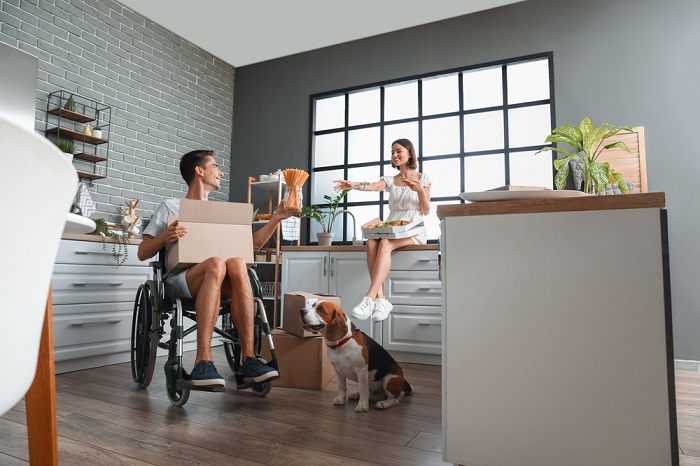Moving is complicated, even in the best circumstances. Some groups, such as disabled senior adults with disabilities, are more likely to move than others. This guide will help make the process as smooth as possible if you’re one of the millions of disabled people in the U.S.
Determine Your Budget and Apply for Moving Grants
You need to know how much you can afford to spend on the move itself. Evaluate your income and current spending along with your savings to figure out what you can afford. While you plan your finances for the move, you might want to research grants available to disabled individuals — or, if you qualify, low-income renters and homeowners. Some grants require specific circumstances, so carefully review the requirements and conditions.
Grants to consider include:
- USDA Section 504 Home Repair Program
- Grants.gov
- Administration for Community Living
- Department of Veterans Affairs
- Administration for Children and Families
- Access Across America by ADAPT
- Disability-related nonprofit organizations in your new community
Complete Multiple Accessibility Checks

You know your needs, but many landlords, real estate agents, and apartment complex staff may not think about accessibility. You need to take steps to make sure the space will work for you.
- Start by getting a verbal accounting of accessibility over the phone with the property contact to eliminate any obvious issues. Then, do a walk-through of the space.
- Have a test day in which you try out all of your disabled-related equipment in the given space, ideally in the unit where you’ll reside in a multi-unit facility. If a wall is slightly different due to a pipe running through one apartment, then an accessible commode might fit in one unit but not another.
- Determine if any accessibility upgrades are necessary, and set timetables with those involved in that process so that they’re complete before you move in.
- Delays are possible due to shortages in building supplies or workers, so it’s wise to build that time into the schedule.
Find Out if Your Disability Benefits Move With You
Check with any case managers or government agencies to verify what benefits are available when you move. Don’t assume anything without checking first, and check with each agency directly. Social Security benefits don’t change as you move within the U.S., for example, while Medicaid eligibility and application processes change from state to state.
Contact your insurance company to find out if your plan will still be valid in the new location and seek recommendations for other plans if necessary. For educational purposes, any child with an Individualized Education Program (IEP) is legally entitled to services at a new school. If the move requires changing schools or districts, you might find it helpful to have a copy of the current IEP on hand to share with the new school in case records don’t transfer immediately. Consider what else you might need to do to make school transitions feel safe for your child.
Ask Your Doctors’ Advice
If your move is between two locations in the same area, check to see if your in-home providers can move with you. Driving from one part of town to another might be a deal breaker. Check the same for yourself: can you still have reliable transportation to your current providers or do you need to find new ones closer to your new home?
Make a list of all of your healthcare providers. Contact each office and ask if they can recommend or refer you to someone new in the area to where you’re moving. This includes pharmacies and mental health providers. If you’ll need more medication doses than usual to cover the transition, you can ask during these conversations.
Plan Logistics for Moving Day
Hiring professional movers can literally and figuratively lighten the load for you. If your disability limits physical labor, then you’ll want to have a solid plan for how to move your belongings across town or across the country.
Create a checklist for moving day. Include any accessibility considerations, such as only stacking boxes to a certain height or leaving a specific measurement of space between boxes so you can navigate the area safely with your mobility aids.
If you or a member of your household has developmental or neurological disabilities, social stories can help. These are basic stories – like “On Tuesday, movers will pack all our belongings into boxes. When we arrive at the new house, our boxes will be there. Here is a picture of your old bedroom. Here is a picture of your new one.” These provide details of the move in simple words and pictures. They can be particularly helpful for children, especially those with disabilities.
Keep Your Necessities With You

During a move, packed items may not be available for some period of time. Make sure you have medications, important documents, a few changes of clothes, and basic toiletries in a separate bag that stays with you. This includes any comfort items, like a familiar pillow or blanket. If you have pets, their items – food, leash, or bedding – need to stay with you as well. If you wrote down the moving plan, keep a copy with you for reference.
Verify Accessibility
Once you’re living in the space, you might discover new ways in which your new home lacks accessibility. You should have ongoing conversations with the property manager about projects to allow your home to work for you. The bathroom and kitchen may need close attention, especially sinks, showers, toilets, and food preparation areas. In other areas, you can often increase accessibility by moving furniture around the space.
Make Planned Changes
Before the move, you made plans for disability services, transitions to new care providers, and updates to necessary paperwork. Now’s the time to make those changes happen if you haven’t already! It’s also time to explore internet assistance programs for disabled people and get new internet in place because most forms you’ll need can now be found online. Other programs in your area might be different from the offerings where you lived previously. Once you have internet access, you can search for those services specific to your new area.
Immediately Apply for a New Disability Parking Placard
If you’re eligible for accessible parking, prioritize the process of getting new tags in your new location. You already know that applications for disability parking placards are time-consuming and sometimes complicated. Every state has a different form with slightly different language so be aware you might need signatures or letters from a new doctor once you’ve moved.


